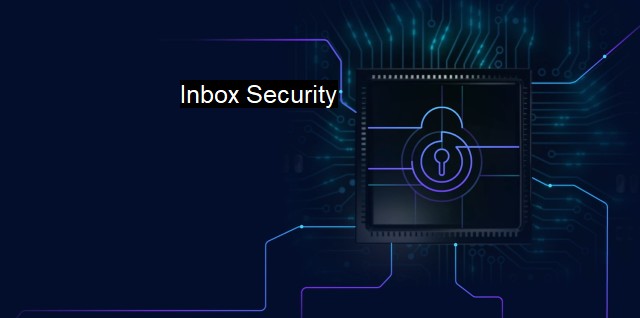What is Inbox Security?
Protecting Your Inbox: Understanding the Importance of Email Security Measures in the Digital Age
Inbox security is a crucial subject in the cybersecurity sphere that deals with safeguarding the integrity, confidentiality, and accessibility of email accounts and their content. In simple terms, it encompasses the practices, methods, and technology employed to protect email inboxes from an array of threats. These threats range from spam and phishing to more sophisticated attacks such as ransomware and business email compromise (BEC). Inbox security plays a critical role in antivirus protection by screening out potentially harmful content, thereby, preventing threats from entering systems or networks through emails.The first line of defense in inbox security is usually spam or junk mail filters. These are built-in features of most email services, designed to automatically move suspicious emails into a separate folder before they can reach the user's main inbox. Despite the mass scale operation, it's challenging for these filters to pinpoint all threats; hackers continually evolve their strategies outsmarting less sophisticated junk mail filters making some of the illegitimate emails slip through cracks.
Another critical component of inbox security is antivirus software. It scans attachments and links in emails for malware, spyware, or phishing schemes to block harmful content effectively. Elements like antivirus scanners frequently update their virus definitions, protecting against even the most recent threats known as zero-day attacks.
Inbox security doesn’t end with preventing malicious messages from landing in inboxes. Its role extends to educating users about identifying and handling potential threats. Despite advancements in technology, human error remains among the leading contributors to successful cyberattacks—making awareness and education key in improving inbox security. When users can identify various typical threats—phishing scams, emails with suspicious links, or requests for sensitive data, they become active participants in safeguarding their information.
User authentication is also crucial for thorough inbox security. By strengthening login procedures using measures like two-factor authentication (2FA) and mandatory password changes, email providers can safeguard against unauthorized access. These steps restrict hackers who might have obtained a user’s password via a data breach or a successful phishing attempt from getting into the email account.
Encryption of emails is another important practice. It involves encoding the contents of an email, ensuring that even if a hacker intercepts the message, they can't decipher it. Only the recipient with the correct decryption key will be able to read the email. Encryption goes a long way in ensuring the confidentiality of data transmitted via email.
With the emergence of cloud computing, email services are now majorly hosted on cloud servers since they offer scalable, manageable, and cost-efficient solutions. That brings a new risk dimension. Although one benefit of going the route is regular patches and updates that won't let any security loopholes open for long, the flip side is the increased vulnerability from hosting millions of users' data at centralized locations, making these servers a potential target for massive cyberattacks.
Even with robust technological defenses, as long as there's human interaction with an email, no inbox security measure can give 100% protection. Instead, it demands steady vigilance from users and continuing innovation from security engineers.
In sum, inbox security is all about maintaining the privacy and safety of electronic mail and safeguarding against any cyber threats. It’s a topical concern for businesses, individuals, and governments alike. It doesn't naturally exist—we create it by implementing numerous security layers including, but not limited to, spam filters, antivirus software, empowering user awareness, introducing secure user authentication, encryption of emails and safe cloud practices. It's continuously improving and adapting to ward off any imaginable or unimaginable cyber threats. Even then, it heavily depends on user behavior - vigilant receivers can make a hacker's sophisticated attack futile.

Inbox Security FAQs
What is inbox security?
Inbox security refers to the measures taken to ensure the safety and protection of email accounts from unauthorized access, cyber threats, and spam. It involves using various security protocols, such as encryption, firewalls, and antivirus software, to safeguard email accounts from malicious attacks.Why is inbox security important in cybersecurity?
Inbox security is vital in cybersecurity as emails are one of the primary avenues that cybercriminals use to launch phishing attacks, malware, and viruses. Without adequate security measures in place, email accounts can be compromised, leading to the theft of sensitive and confidential information. Inbox security helps prevent cyber attacks and safeguards email accounts from potential threats.What are some strategies for enhancing inbox security?
Some strategies for enhancing inbox security include using strong passwords, enabling two-factor authentication, avoiding clicking on dubious links and attachments, regularly updating antivirus software, and being cautious about sharing sensitive information through email. Additionally, users should avoid using public Wi-Fi networks and always verify the sender's identity before responding to any email.What are some common inbox security threats?
Some common inbox security threats include phishing attacks, spam, malware, and ransomware. Phishing attacks involve cybercriminals sending emails that appear to be from reputable sources, like banks or other financial institutions, to trick users into revealing sensitive information. Spam refers to unwanted and unsolicited emails that are often sent in bulk. Malware and ransomware are malicious software that can be spread through emails and can cause significant damage to a user's system.| | A | | | B | | | C | | | D | | | E | | | F | | | G | | | H | | | I | | | J | | | K | | | L | | | M | |
| | N | | | O | | | P | | | Q | | | R | | | S | | | T | | | U | | | V | | | W | | | X | | | Y | | | Z | |
| | 1 | | | 2 | | | 3 | | | 4 | | | 7 | | | 8 | | |||||||